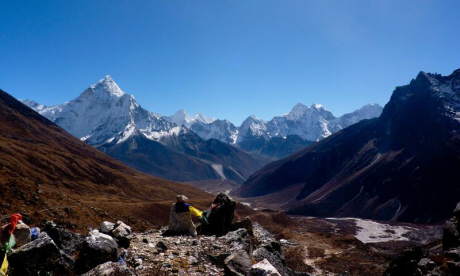
Wanderlust's top tips for trekking to Everest Base Camp
A During the dry season, which runs from October to May. Post-monsoon (October until Christmas) offers days that are generally clear, allowing for good views of the freshly snow-covered mountains, but the nights get very cold from December to February. Pre-monsoon (March and April), it’s usually cloudy by late morning and the mountains are less snowy, but it’s Everest season, so Base Camp and the trails are buzzing with the world’s climbing elite. Lower down, it’s spring – flowers are everywhere.
A: Qatar Airways is the best option to Kathmandu, with daily flights from London and Manchester. Gulf Air also flies Heathrow to Kathmandu. A number of airlines run the mountain flight from Kathmandu to Lukha, the start of the base camp trek. Yeti Airlines is a good option and there's a 10% discount for booking a round trip.
It's easier to use a travel agent to book these.
A: The chance of dying from altitude sickness is extremely slim. All you need to do is follow the advice given in any trekking guidebook: ascend slowly – average 1,000m every four days – and descend immediately if you start to feel unwell. Most people experience an altitude headache, loss of appetite and poor-quality sleep at some point. This is mild altitude sickness and is quite normal (and quite bearable). Also, it shouldn’t last for long. There is a chance you’ll experience worse symptoms, but they are easily treated by descending – often they will disappear with just a couple of hundred metres of descent (see Wanderlust’s April/May health pages for tips on dealing with altitude).
A The altitude ranges from 2,600m to 5,545m, so temperatures vary significantly. Normally the mornings are warm, and walking in shorts and T-shirts is pleasant. But if the afternoon is cloudy, the temperature can drop to just above freezing. At night, up high, it will definitely drop below freezing – expect -10°C.
A The Maoists were levying a ‘tax’ from trekkers in Oct/Nov 2006. With the peace agreement that was signed in November 2006, hopefully they won’t return. Having said that, even if they do, all they ask for is Rs100 (75p). They are very polite and give you a receipt. In fact, many travellers quite enjoy meeting them.
A The only other thing to watch out for is the yaks. Always pass them on the uphill side – they are no more aggressive than cows, but they still have big sharp horns, so stay away.
It’s highly recommended that you register with your embassy, telling them where you are trekking and when you expect to return. It’s simple to do – just drop an email to the British Embassy in Kathmandu at [email protected].
A Yes you can. There are lots of teahouses (mountain inns) and it’s extremely difficult to get lost! But you will need to organise a mountain flight, understand the effects of altitude sickness and plan an itinerary that allows you plenty of time to acclimatise. Also, for ethical reasons you should consider hiring a porter to carry your kit – it lets you enjoy yourself and provides much-needed income.
A They both have advantages. Camping is warmer once you're in bed, and having your own cook means you have more control over hygiene. But lodges have electric lights and warms rooms for sitting around in. More importantly, lodges give more money to the local communities, so are probably the best option.
You need to be reasonably fit – a hill-walker, or someone who takes regular exercise. Although many of the days are easy, the trek from Lobuje to Base Camp is a long day,
made difficult by the 5,000m-plus altitude.
A Yes, it’s great to use a porter. It gives someone a job. But you do need to treat your porter well. This means following the International Porter Protection Group (IPPG) guidelines. They consist of making sure your porter is well-equipped, doesn’t carry more than 30kg, has insurance and receives the same medical care you would expect for yourself (for full guidelines visit www.ippg.net.
Check out our Everest Base Camp travel guide for more features, travel tips and ideas
Hiking to Everest Base Camp | Destinations... More
Out in the cold: Stay safe (and warm) with our top tips | Advice... More
Check out our Nepal guide for other things to do while your there | Plan a trip... More
4 classic mountain ranges and 3 lesser-knowns | Inspire me... More